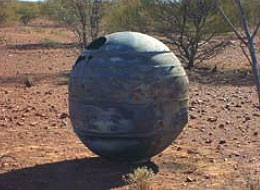|
Author
|
Topic: Eighteen-year-old solid rocket motor casing found in Australia
|
Robert Pearlman
Editor Posts: 42981
From: Houston, TX
Registered: Nov 1999
|
 posted 10-15-2008 10:27 AM
posted 10-15-2008 10:27 AM
   
NASA's Orbital Debris Quarterly News: Eighteen-year-old solid rocket motor casing found in Australia The Australian outback finally revealed a nearly two-decades-old secret in July when a launch vehicle rocket motor casing was found during a routine muster of cattle on a three-million-acre pastoral property. First spotted by Mr. Arthur Taylor while flying a Cessna aircraft in the muster operation, the casing appeared in relatively good condition and did not seem to be very old. Mr. Michael White forwarded numerous photos of the object to the NASA Orbital Debris Program Office, including one with a clear serial number next to the nozzle attachment point.  Using the serial number, NASA Kennedy Space Center personnel were able to trace the motor casing to a Delta 2 launch vehicle used on 12 June 1990 to deliver the Indian INSAT-1D geosynchronous spacecraft from the Cape Canaveral Air Force Station, Florida. This solid rocket motor served as the launch vehicle's third stage (U.S. Satellite Number 20645, International Designator 1990-051C), which carried the payload from a low altitude parking orbit into a geosynchronous transfer orbit of 135 km by 39,750 km with an inclination of 27.2 degrees. Reentry of the stage occurred a few months later. The object joins similar solid rocket motor casings found in Saudi Arabia, Thailand, and Argentina during the past several years.
|
LCDR Scott Schneeweis
New Member Posts:
From:
Registered:
|
 posted 10-15-2008 11:37 AM
posted 10-15-2008 11:37 AM
   
Looks like a Thiokol Star 37 casing...------------------
Scott Schneeweis
http://www.SPACEAHOLIC.com/ |
Jay Chladek
Member Posts: 2272
From: Bellevue, NE, USA
Registered: Aug 2007
|
 posted 10-15-2008 03:12 PM
posted 10-15-2008 03:12 PM
   
One of the companies at the Space & Defense conference in Omaha, NE last week also had a similar casing on display. It was an object that landed in Oklahoma a few years back and as I recall it also came from a Delta rocket. |
NASAVideographer
New Member Posts:
From:
Registered:
|
 posted 10-15-2008 11:47 PM
posted 10-15-2008 11:47 PM
   
Why isn't that thing flat as a pancake? Seems like an impact would have buried that thing...James B.
http://nasavideographer.blogspot.com/ |
LCDR Scott Schneeweis
New Member Posts:
From:
Registered:
|
 posted 10-16-2008 12:04 PM
posted 10-16-2008 12:04 PM
   
My calculations are for a terminal velocity of 134 feet per second at sea level (~90 miles per hour). This assumes: a Star 37 casing, which at burn-out weighs ~160 pounds, has a cross sectional area of 15 feet (60 inches tall by 36.5 inch diameter); and a drag coefficient of .5 (bit higher then that of a rough sphere). These casings are fabricated from high tinsel strength titanium; coupled with the relatively low impact velocity and other factors (i.e. angle of descent, modulus of elasticity of the soil), its easy to understand how the casing can remain intact. |
freshspot
unregistered
|
 posted 10-17-2008 04:07 AM
posted 10-17-2008 04:07 AM
 
Scott, for a writer like me the fact that you would 1) know how to do a calculation like that and 2) want to actually take the time to do it is absolutely amazing. Thank you for being a part of these boards. Dave Scott
(not the astronaut)
http://www.apolloartifacts.com/
|
cspg
Member Posts: 6210
From: Geneva, Switzerland
Registered: May 2006
|
 posted 10-17-2008 08:32 AM
posted 10-17-2008 08:32 AM
   
Who now owns those casings?Chris. |
mikepf
Member Posts: 441
From: San Jose, California, USA
Registered: Mar 2002
|
 posted 10-17-2008 02:48 PM
posted 10-17-2008 02:48 PM
   
Scott, I just can't let this go by without adding my comment that you also always amaze me with your knowledge of rocketry hardware. I must admit that many of your posts fly right over my head, but I am fascinated by reading them anyway. Thanks from me too for sharing your knowledge with us.
Regards,
Mikie |
LCDR Scott Schneeweis
New Member Posts:
From:
Registered:
|
 posted 10-17-2008 04:11 PM
posted 10-17-2008 04:11 PM
   
Thanks for the kudo's guys but its really easy to do if the characteristics of the object are known... NASA provides a great Terminal Velocity applet thats "Sailor proof". |












